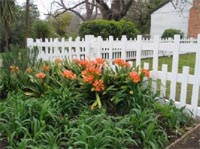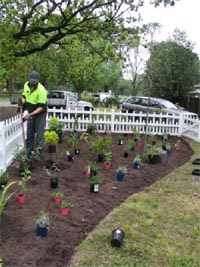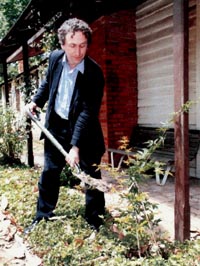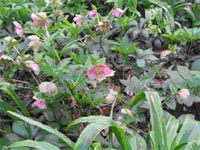Garden news - Spring/summer 2011
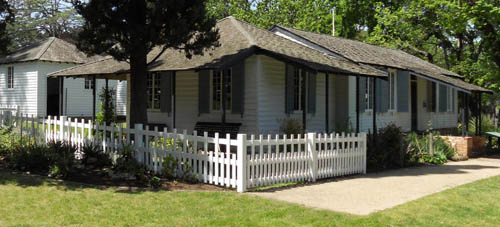
There has been a lot happening in the garden over the last two years. On the 3 October 2010 we celebrated the 171st year of La Trobe’s arrival in Melbourne by planting a cutting of an Olive tree
Olea europaea. It came from
Ballam Park in Frankston that was owned by the Liardet Family in the late 1840s.
Georgiana McCrae gave her friend there a cutting from one of the olive trees growing in her orchard at Arthur’s Seat. The tree at
Ballam Park still stands and is very old. (‘Olive Tree returned to
McCrae Homestead’, Victorian News/National Trust, November 2010)
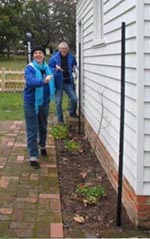 We have also started the espaliering process on our four heritage apples. We are trying to replicate the
Edward La Trobe Bateman drawing
'Kitchen and store in interior courtyard', where there are apples growing up the front of the kitchen block. They were propagated at the
We have also started the espaliering process on our four heritage apples. We are trying to replicate the
Edward La Trobe Bateman drawing
'Kitchen and store in interior courtyard', where there are apples growing up the front of the kitchen block. They were propagated at the
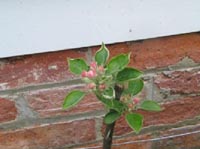 National Trust property,
Rippon Lea, and planted in winter 2010. After much advice and trepidation, they were pruned down ready for the 2011 growing season.
National Trust property,
Rippon Lea, and planted in winter 2010. After much advice and trepidation, they were pruned down ready for the 2011 growing season.
 The gardening volunteers got together in winter to plant a huge range of bulbs that were donated by the bulb company Hancock and Co. In September, the bulbs started flowering and looked fantastic.
The gardening volunteers got together in winter to plant a huge range of bulbs that were donated by the bulb company Hancock and Co. In September, the bulbs started flowering and looked fantastic.
Another development is our fantastic new fence, which is an interpretation of an early colonial fence. It gives the cottage an early colonial feeling and adds to the visitor’s experience of Melbourne in the 1840s.
(see picture at page head)
With the help of the City of Melbourne, Citywide,
the National Trust, the Friends of La Trobe’s Cottage and the Garden of Eden Nursery in Albert Park and other sponsors, the garden over the last two years has been improving. Carefully researching what plants were available to La Trobe in the 1840s, the Friends have been slowly adding to the garden, creating a valued asset for the Cottage. It is a great challenge to source the original species, as today any cultivars or hybrids are usually the only plants available.
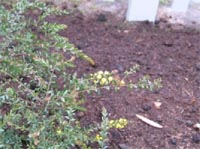 We are fortunate to have in the State Library of Victoria copies of La Trobe’s
letters to his daughter Agnes, where he often mentions the garden, and also a number of drawings by his cousin,
Edward La Trobe Bateman, which we can use to identify plants. We also have a list of plants sent to Charles from his friend Ronald Campbell Gunn, who was a Tasmanian public servant and amateur botanist. Of course, we cannot put them all back as some of them now are considered environmental weeds, but there are still a large number to choose from.
We are fortunate to have in the State Library of Victoria copies of La Trobe’s
letters to his daughter Agnes, where he often mentions the garden, and also a number of drawings by his cousin,
Edward La Trobe Bateman, which we can use to identify plants. We also have a list of plants sent to Charles from his friend Ronald Campbell Gunn, who was a Tasmanian public servant and amateur botanist. Of course, we cannot put them all back as some of them now are considered environmental weeds, but there are still a large number to choose from.
There are lots of good old favourites such as Mock orange Philadelphus sp.
Plectranthus Plectranthus ecklonii and English lavander Lavandula angustifolia. These are plants you can use in your garden, as they are drought tolerant and if you like natives, as La Trobe did, we have planted the following: Emu bush
Eremophila maculata, White correa Correa alba, Correa reflexa var.
reflexa and Happy Wanderer Hardenbergia violacea.
The three natives named after La Trobe are doing really well. The Golden dust wattle
Acacia acinacea syn. Latrobei has settled in and flowered, the
Rosemary grevillea
Grevillea rosmarinifolia subspecies rosmarinifolia syn.
G. latrobei has grown very strongly and also flowered. The Emu bush
Eremophila latrobei, which still retains his name and was named by
Baron Ferdinand von Mueller when La Trobe was Lieutenant-Governor, has surprised us with unusual black new growth - at first we thought it was diseased - and it has flowered too.
Two La Trobe family members have visited the Cottage in recent years. Dr Charles La Trobe Blake planted the Banksia rose and Dr Henry de La Trobe planted a Weeping elm
Ulmus glabra ‘Camperdownii’, which unfortunately died due to
the drought. A kind donation of a new tree by the Friends of the Elms
replaced it in March 2011 and we have now designed a new garden bed
around this tree
click here for Plant
List.
La Trobe was fond of cacti and succulents and built a magnificent
rockery at the entrance of ‘Jolimont’. It was the height of fashion at
the time and would have made an impressive statement at the beginning of
the carriageway. It contained a grotto where you could sit and was
between 12 to 14 feet (about 4 metres) high. La Trobe wrote to his
daughter Agnes in 1850 that the grotto is covered with shrubs and
strange plants. We do not know what varieties of cacti or succulents La
Trobe grew, but we have sourced plants that were available during the
1840s
click here for Plant
List.
We also discovered that there are some wild succulents along the railway at Jolimont. It is quite possible that some of these plants came from the original rockery. Cuttings have been propagated from this stock and will be planted in the garden when they have developed roots.
We are show-casing plants that would have been available in the 1840s. This will give the garden an authenticity and distinguish it from the later Victorian period gardens. Where we have not been able to source the exact old species we have chosen plants that are the closest we can obtain.
search the society and
FOLTC web sites

